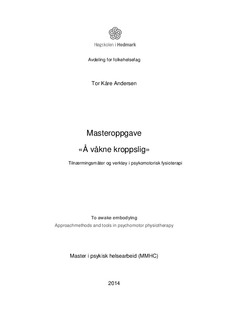«Å våkne kroppslig». Tilnærmingsmåter og verktøy i psykomotorisk fysioterapi
Master thesis
Permanent lenke
http://hdl.handle.net/11250/2354194Utgivelsesdato
2015Metadata
Vis full innførselSammendrag
Hensikten med studien er å få kunnskap om erfarne psykomotoriske fysioterapeuters tilnærmingsmåter og verktøy i behandling av pasienter med langvarige muskel/skjelettsmerter og diffuse kroppsplager.
Metode: Kvalitativt design. Sju psykomotoriske fysioterapeuter ble intervjuet. Temastyrt intervjuguide ble benyttet. Dataene analysert etter Lindseth & Nordberg (2004) sin fenomenologisk hermeneutiske metode.
Funn: Følgende hovedkategorier med underkategorier ble analysert fram:
Hovedkategorier 1: Et åpent hjerte og sinn, med underkategoriene: Å vise interesse og engasjement for pasienten, Å la pasienten tilpasse seg situasjonen, Å være klangbunn for det meste.
Hovedkategori 2: Å ta kroppens erfaring på alvor, med underkategoriene: Sammen om oppdagelse i kropp og liv, ekspert på eget liv og respektere kroppslige stopp-punkter.
Hovedkategori 3: Verktøy i bruk, med underkategoriene: Tune seg inn, terapeutisk bruk av hender, intuisjon og gylne øyeblikk.
Konklusjon: Psykomotoriske fysioterapeuter arbeider i tråd med trinnene i en recoveryprosess ved behandling av pasienter med langvarige muskel/skjelettsmerter. For å bidra til oppvåkning, gjenoppbygging og utvikling av motstandskraft/mestringsevne, møter de pasientene med et åpent hjerte og sinn. Terapeutene bruker mye tid på å hjelpe pasientene til å bli gradvis bedre kjent med kroppen og hva den signaliserer til dem. De forsøker å la pasientene få være med på en reise/oppdagelse om seg selv og sitt liv, som også kan gi håp og tro om at endring er mulig. De er bevisst på ikke å presse på i samhandlingen, for å unngå at det blir for voldsomt. Terapeutene bruker aktivt sin egen intuisjon, for å veilede pasienten på sin vei mot endring. Vektlegging av intuisjon understreker behovet for kritisk evne i valideringsprosessen. Dette er en sentral oppgave i den kommunikasjon som denne studien har adressert. English abstract: Aim: The purpose with the study is to gain knowledge about how experienced physiotherapists approach, and their use of tools in the treatment of long-term muscle and skeletal pain, and diffuse bodily issues. Methodology: Qualitative design. Seven psychomotor physiotherapists were interviewed using a theme directed interview guide. The data were analyzed using a phenomenological and hermeneutic method developed by Lindseth & Nordberg (2004). Results: These main categories with subcategories were the result of the analysis. Main category 1: An open heart and mind: Subcategories: To show interest in and commitment in the patient, to let the patient adapt to the new situation, to help the patient to reflect on the themes that occur. Main category 2: Take the experience of the body seriously: Subcategories: Togetherness in the discovery of body and life, expert on your own life, and respect the bodily stop-points. Main category 3: Tools in use: Subcategories: Tune in and focus on the task at hand, therapeutic use of hands, of intuition and of golden moments. Conclusion: Psychomotor physiotherapists work in line with the steps of a recovery process in the treatment of patients with long-term muscular and skeletal pain. This is important to contribute to the awakening, re-construction and to develop power for resistance and coping ability. The therapists use much time to help the patients to learn how to know and, therefore to understand their body, so that they can learn to read the bodily signals. The therapists encourage the patients to embarke on a journey of self discovery, to understand more about themselves and their lives; with the purpose to give hope and belief that change is possible. The therapists are cautious not to use too much pressure during interaction. The therapists use their intuition actively to guide the patients in their quest for change. The emphasis on intuition underlines the requirement of critical abilities in the process of validation. That is a central task in the communication that this study has addressed.
